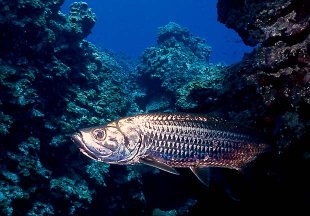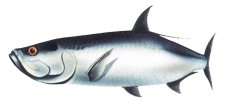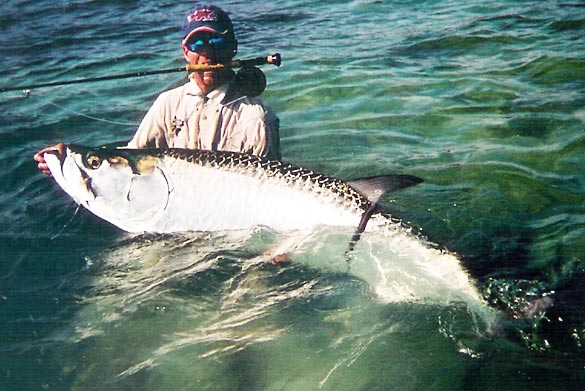|
TARPONThe Silver King
Tarpon World Record - 286 lbs. Kingdom: Animalia Phylum: Chordata Class: Actinopterygii Order: Elopiformes Family: Megalopidae Genus: Megalops This one's scientific name is derived from the Greek words "mega", for large, and "lops", for face. Literally, it is a big faced fish. Gotta love those Greeks!
Where to find them and their Life Cycle There are two distinct types of Tarpon in the same genus,based on their native habitat. They are the same fish, but come from different sides of the tracks. For this purpose, we will focus on Megalopidae Atlanticus. One guess where it calls home… This monster of the deep is found plentifully in coastal areas of the Atlantic Ocean, but spawning occurs in the open ocean. Also known as the Silver King, they grow to a mammoth size of up to 8 feet in length, and weigh more than 200 pounds. It is believed that the max weight can go to over 350 pounds! Keeping true to it's reputation, the world's record was hooked in 1956, weighed 286 pounds, and was over 8 ½ feet long! Now THAT would be a story of the one that got away", wouldn't it? The name "Silver King" is derived from their coloration. Green on top with bright silver sides, an upturned mouth, and an elongated "ray" off the dorsal fin that extends almost to the tail. SPECIAL NOTE: This fish can fill an air bladder from which it draws oxygen. They will surface in oxygen poor waters and fill their air bladder for this purpose. Another few hundred years of evolution and we may actually see a "LAND SHARK"! Almost like Swordfish and Sailfish, Tarpon will go through wild acrobatics when hooked. Jumping, thrashing, and stubborn tugs-of-war are the order of the day. The jaw is likened to concrete, so if you DO get a good hook set, you are fortunate. This is why Tarpon anglers always ask "how many did you jump" as opposed to "how many did you catch?". The fight can last an hour or more.
What they eat and when The diet of these monstrous marine marauders is mostly other fish, and just about any crustacean that happens along. These fish eat voraciously in small schools that can eradicate a group of smaller fish in moments. They also move quickly, so they are big AND in shape, as you will see when you hook one for the first time. How we eat them and how to cook 'em By and large, this fish is NOT eaten. The flesh is oily and is not palatable for us Homo sapiens. That doesn't mean it cannot be eaten, but you will be hard pressed to find recipes for it. Other species like this one and the differences There is another of this species that is almost identical to this one. That is the Megalopidae Cyprinoides, that calls the Indo-Pacific home. It looks like an Atlantic Tarpon, but grows much smaller, only about 30 to 40 pounds as a mature adult. Other than that, it's the same fish. For further information, please CONTACT US or visit our ONLINE FLY SHOP.
Return from Tarpon to Fish Species
|








